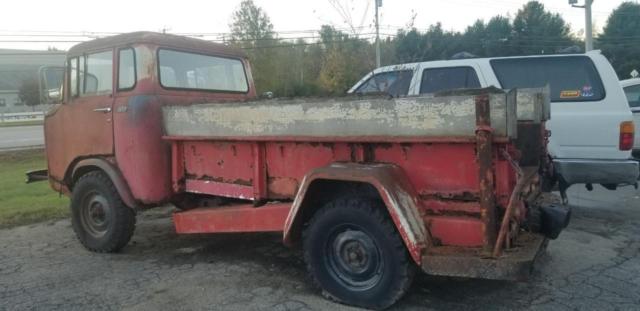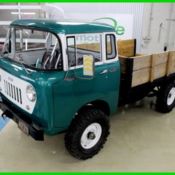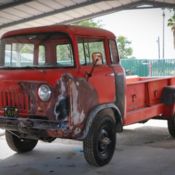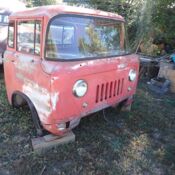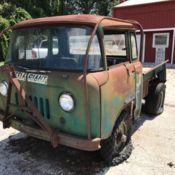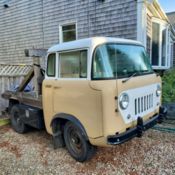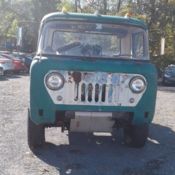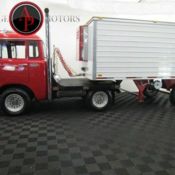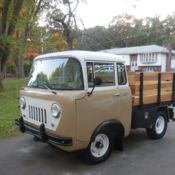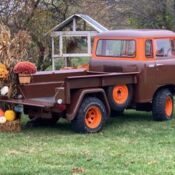1956-1965 Jeep (Forward Control) FC-170 Barn Find No Reserve !!
1956 Jeep FC170
1956-1965 Jeep FC - 170 (Forward Control)unsure of year, Found behind an old barn, was told it had been there for 30+ years.looks to be nearly complete, but very rough. It has engine, and all running gear, unsure of size.has a front winch, and rear PTO shaft.neat little project.Please see pics, this jeep is rough, and will need a full restoration, or used for parts.
Buyer is responsible for all shipping.
No returns. No refunds, No Reserve.
For locals, this can be seen anytime this week at
Peterborough Collision Center75 Jaffrey rd, Peterborough NH 03458
More info from Wikipediahttps://en.wikipedia.org/wiki/Jeep_Forward_Control
Jeep Forward Control From Wikipedia, the free encyclopedia Jump to navigation Jump to search
| Jeep |
| 1956-1965 |
| Brooks Stevens |
| Truck |
| Front engine, four-wheel drive |
|
|
|
| 147.5in (3,746mm) (FC-150)[3] 181.5in (4,610mm) (FC-170, FC-170 DRW) |
The Jeep Forward Control is a truck that was produced by Willys Motors, later named Kaiser Jeep, from 1956 to 1965. It was also assembled in other international markets. The layout featured a cab over (forward control) design.
The Forward Control models were primarily marketed as work vehicles for corporate, municipal, military, as well as civilian use. Regular pickup box beds were standard, but customers were offered a large number of "Jeep approved" specialized bodies from outside suppliers. These ranged from simple flatbeds to complete tow trucks, dump trucks, and fire trucks. The vehicles were also manufactured under license in India and Spain.
DesignWillys produced utility vehicles that remained almost unchanged since 1947. As the marketplace grew more competitive in the 1950s, management developed a new range of modern cab and body trucks. Independent designer that was contracted by Willys since the 1940s, Brooks Stevens, used styling cues from full-size cab-over-engine trucks for this new futuristic-looking space-efficient vehicle with the center grille panel made to imitate the classic seven-slot Jeep design.[4] The unconventional forward control layout and "helicopter look" of the cab was too unusual for mainstream buyers during that era, but they were successful in specialty markets that included airport service vehicles, tow trucks, and railroad crew trucks that could ride the rails.[5] Numerous versions of the Forward Control Jeeps were manufactured for general and specialized applications with 1957 being the top production with almost 10,000 vehicles built that year.[6]
Engineering was based on existing CJ-5. Power came from the Hurricane F-head and L-head 4-cylinder engines. The updates in 1958 on both the FC-150 and 170 versions had attained a goal established by Willys engineers to design a versatile commercial vehicle in which the ratio of the vehicle's curb weight to its payload was 1 to 1.[7] According to the Society of Automotive Engineers (SAE), this was regarded as the lowest ratio offered by domestic manufacturers at that time within the standard light-duty commercial vehicle segment.[7] The FC layout offered advantages including a short turning radius and large cargo bed size given the compact overall length.
Proposals included a "Forward Control Commuter" design that may have been among the earliest minivan-type vehicles. Three operational concept cars were built by Reutter in Stuttgart, West Germany. Brooks Stevens was also involved in the transformation of this truck platform into a passenger vehicle.
FC-170 1957 Jeep model FC-170 with pickup cargo bed German fire engine van body Forward Control 1961 FC-170 Australian rescue truckIntroduced in 1957, FC-170 models had a 103in (260cm) wheelbase with a 108in (270cm) bed. This was achieved by the forward-control layout. A 1958 concept version of the FC-170 featured a 108in (270cm) wheelbase. This was required to accommodate a new 272cuin (4.5L) V8 engine (based on the Ford Y-block) with a new transfer case. A new 3-speed automatic transmission (based on the Ford Cruise-O-Matic) was only available with the inline-6 due to possible driveshaft angle issues. A T-98 4-speed manual was available with both engines. This model had a gross weight of 7,000lb (3,200kg).[11]
Production
The FC Jeeps were exhibited to Jeep dealers in a closed-circuit telecast on November 29, 1956, and were on display for the public at the December 1956 National Automobile Show in New York City. The FC-150 went on sale at dealer showrooms on December 12, 1956. The initial response to the four-wheel drive FC Jeeps was favorable. Their best sales year came in 1957, when 9,738 trucks were sold. After the introduction of the FC-170 in 1957, FC-150 sales dropped to 1,546 units in 1959, before rebounding to 4,925 in 1960.
Brooks Stevens made a rendering around 1960 for a possible facelift for the FC-series.[12]
The FC models did not become the big sellers that Willys had hoped. Total production in nine years was just over 30,000 units. The FC line was discontinued in 1964.
- Make: Jeep
- Model: FC170
- SubModel: FC-170
- Type: Forward Control
- Year: 1956
- Mileage: 1
- VIN: AOR
- Color: Red
- Engine size: 6cyl
- Number of cylinders: 6
- Fuel: Gasoline
- Transmission: Manual
- Drive type: 4WD
- Interior color: worn
- Options: 4-Wheel Drive, winch, rear PTO shaft
- Vehicle Title: Clear Want to buy? Contact seller!
